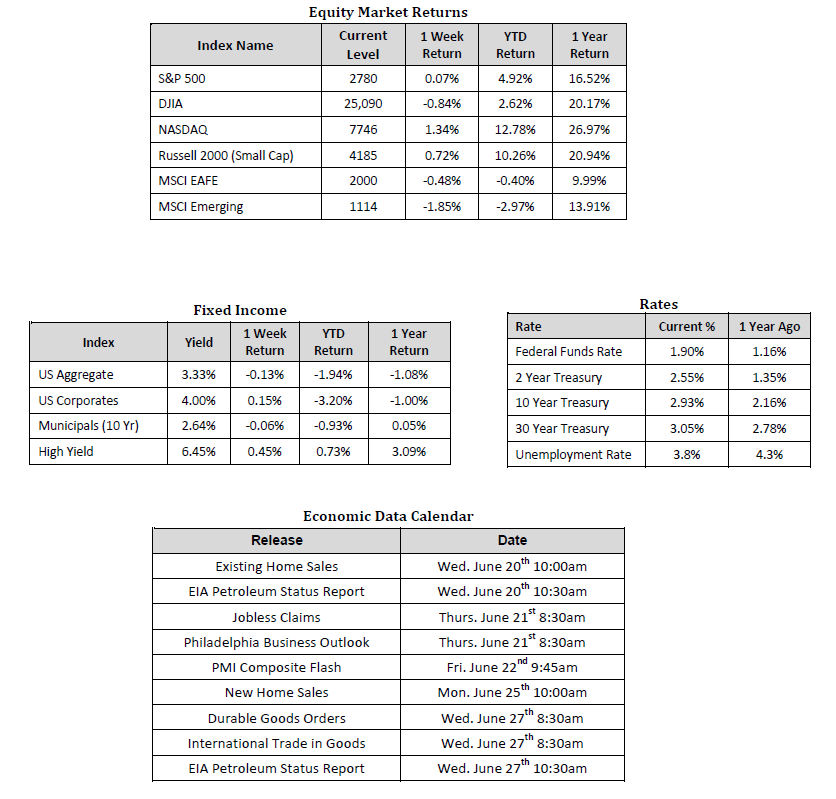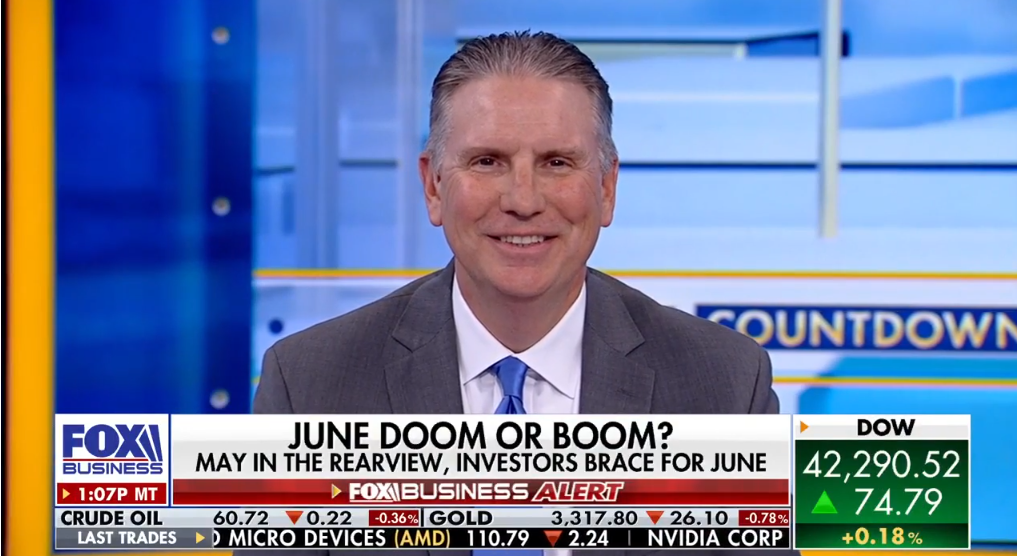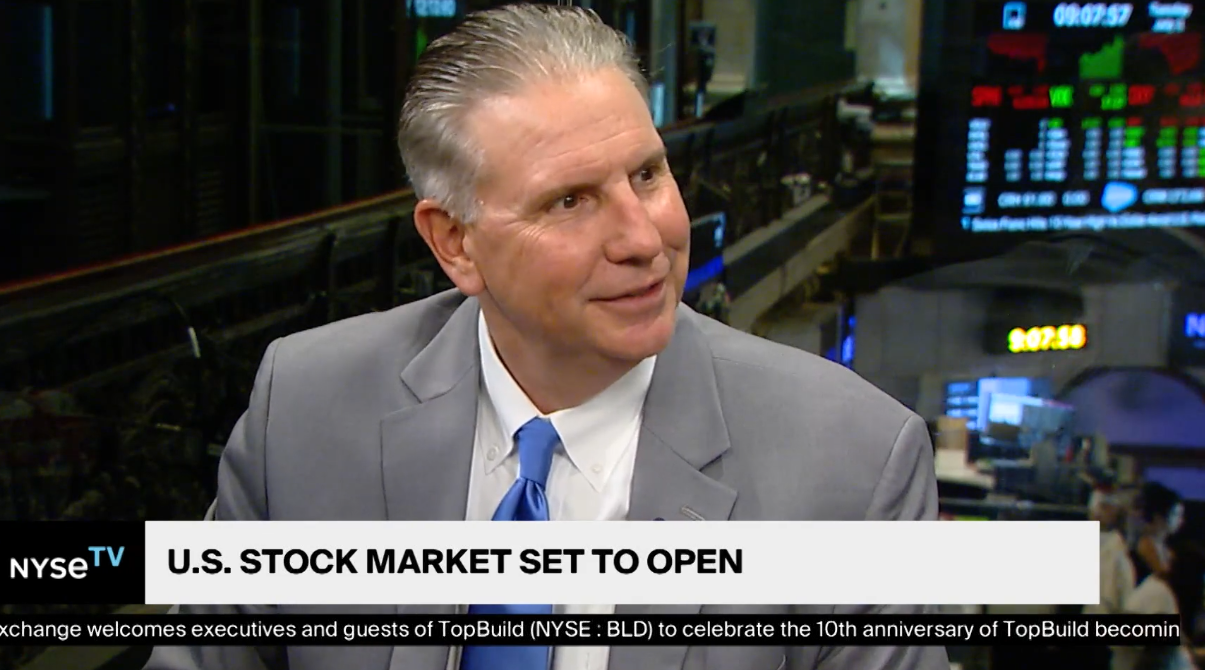
Should Investors be concerned by the Federal Reserve’s Projected Path of Interest Rate Hikes?
Market Overview

Sources: Sources for data in tables: Equity Market and Fixed Income returns are from JP Morgan as of 06/18/18. Rates and Economic Calendar Data from Bloomberg as of 06/19/18. International developed markets measured by the MSCI EAFE Index, emerging markets measured by the MSCI EM Index. Sector performance is measured using GICS methodology.
Happening Now
Developed markets held relatively flat following a week largely dominated by news surrounding the Federal Reserve and their ongoing process of increasing interest rates. We’ll dive deeper into an analysis of the Federal Reserve’s decision to raise the Federal Funds rate another 25bps (i.e. 0.25%) shortly, but first an update on the markets. The S&P 500 Index held strong at a level of 2780, representing a modest increase of 0.07%, while the Russell Midcap gained 0.25% and the Russell 2000 Index, a measure of the Nation’s smallest publicly traded firms, gained 0.72% for the week. On the international equities front, developed markets fell 0.49% last week while emerging markets declined by 1.85%. Fixed income markets appeared to be unfazed by the news of another increase in the Federal Funds Target Rate, with the 10 year U.S. Treasury yield unchanged at 2.92%. The U.S. Dollar continued on with its bullish stance, increasing 1.26%.
Rates, Rates, Rates, and the impending doom expected to follow an increase in interest rates is all we’ve heard about from financial news pundits for – what feels like- the past five years. Despite these dire concerns regularly touted by the financial media, capital markets continue to push higher while absorbing increased rates with relative ease thus far. So, how high is too high and at what level can we expect elevated interest rates to start to hinder economic growth? Obviously no one has a crystal ball and forecasting the exact level the Federal Funds Target Rate would have to reach in order to reverse the near decade long trend of positive economic growth is an arduous task at best, but we can look to the past for some potential indication of this level.
As it currently stands, the Federal Reserve maintains a target interest rate between 1.75% and 2.00%, and their median projection suggests five additional, potential rate hikes by the end of 2019. If this projection proves true, the Federal Funds Target Rate could settle in a range between 3.00% – 3.25% by the end of 2019. Our research has shown that the real Federal Funds rate, which is the Federal Funds rate minus the inflation rate, would have to reach a level of 2.5% before the negative effects of increased borrowing costs started to weigh on the growth of the economy. The growth potential of the economy, unencumbered by elevated interest rates, begins to look significantly more promising when taking into account that the most recent inflation reading indicated an annual inflation rate of 2.2%. Given this level of inflation, the real Federal Funds rate stands to remain below the aforementioned restrictive rate well into 2020 and potentially beyond.
Although the current and expected level of interest rates cause much less concern when viewed through a historical perspective and economic activity continues to trend in a positive direction, downside risks and economic uncertainties still remain. With that said, portfolio diversification becomes increasingly important during times of heightened uncertainty, and we encourage investors to revisit the diversification that may, or may not, be in place within their existing portfolios.
Important Information and Disclaimers
Disclosures: Hennion & Walsh is the sponsor of SmartTrust® Unit Investment Trusts (UITs). For more information on SmartTrust® UITs, please visit www.smarttrustuit.com. The overview above is for informational purposes and is not an offer to sell or a solicitation of an offer to buy any SmartTrust® UITs. Investors should consider the Trust’s investment objective, risks, charges and expenses carefully before investing. The prospectus contains this and other information relevant to an investment in the Trust and investors should read the prospectus carefully before they invest.
Investing in foreign securities presents certain risks not associated with domestic investments, such as currency fluctuation, political and economic instability, and different accounting standards. This may result in greater share price volatility. These risks are heightened in emerging markets.
There are special risks associated with an investment in real estate, including credit risk, interest rate fluctuations and the impact of varied economic conditions. Distributions from REIT investments are taxed at the owner’s tax bracket.
The prices of small company and mid cap stocks are generally more volatile than large company stocks. They often involve higher risks because smaller companies may lack the management expertise, financial resources, product diversification and competitive strengths to endure adverse economic conditions.
Investing in commodities is not suitable for all investors. Exposure to the commodities markets may subject an investment to greater share price volatility than an investment in traditional equity or debt securities. Investments in commodities may be affected by changes in overall market movements, commodity index volatility, changes in interest rates or factors affecting a particular industry or commodity.
Products that invest in commodities may employ more complex strategies which may expose investors to additional risks.
Investing in fixed income securities involves certain risks such as market risk if sold prior to maturity and credit risk especially if investing in high yield bonds, which have lower ratings and are subject to greater volatility. All fixed income investments may be worth less than original cost upon redemption or maturity. Bond Prices fluctuate inversely to changes in interest rates. Therefore, a general rise in interest rates can result in the decline of the value of your investment.
Definitions
MSCI- EAFE: The Morgan Stanley Capital International Europe, Australasia and Far East Index, a free float-adjusted market capitalization index that is designed to measure developed-market equity performance, excluding the United States and Canada.
MSCI-Emerging Markets: The Morgan Stanley Capital International Emerging Market Index, is a free float-adjusted market capitalization index that is designed to measure the performance of global emerging markets of about 25 emerging economies.
Russell 3000: The Russell 3000 measures the performance of the 3000 largest US companies based on total market capitalization and represents about 98% of the investible US Equity market.
ML BOFA US Corp Mstr [Merill Lynch US Corporate Master]: The Merrill Lynch Corporate Master Market Index is a statistical composite tracking the performance of the entire US corporate bond market over time.
ML Muni Master [Merill Lynch US Corporate Master]: The Merrill Lynch Municipal Bond Master Index is a broad measure of the municipal fixed income market.
Investors cannot directly purchase any index.
LIBOR, London Interbank Offered Rate, is the rate of interest at which banks offer to lend money to one another in the wholesale money markets in London.
The Dow Jones Industrial Average is an unweighted index of 30 “blue-chip” industrial U.S. stocks.
The S&P Midcap 400 Index is a capitalization-weighted index measuring the performance of the mid-range sector of the U.S. stock market, and represents approximately 7% of the total market value of U.S. equities. Companies in the Index fall between S&P 500 Index and the S&P SmallCap 600 Index in size: between $1-4 billion.
DJ Equity REIT Index represents all publicly traded real estate investment trusts in the Dow Jones U.S. stock universe classified as Equity REITs according to the S&P Dow Jones Indices REIT Industry Classification Hierarchy. These companies are REITs that primarily own and operate income-producing real estate.



